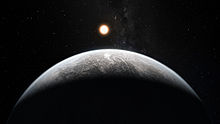HD 85512 b
Template:Planetbox begin Template:Planetbox image Template:Planetbox star Template:Planetbox orbit Template:Planetbox character Template:Planetbox discovery Template:Planetbox reference Template:Planetbox end

HD 85512 b is an exoplanet orbiting Gliese 370, a K-type main-sequence star approximately 36 light-years from Earth in the constellation of Vela.[1][2]
Due to its mass of at least 3.6 times the mass of Earth, HD 85512 b is classified as a near Earth sized exoplanet (<5M⊕) and is one of the smallest exoplanets discovered to be just outside the inner edge of the habitable zone.[2] HD 85512 b, along with Gliese 581 d, was once considered to be one of the best candidates for habitability in 2011.[3]
Detection and discovery
HD 85512 b was discovered by scientists at University of Geneva, Switzerland,[3][4] led by Swiss astronomer Stéphane Udry[5] of the Guaranteed Time Observations (GTO) program of High Accuracy Radial velocity Planet Searcher (HARPS), a high-precision echelle spectrograph installed on ESO's 3.6 m telescope at La Silla Observatory in Chile.[6] The team used the Doppler spectroscopy technique which determines the minimum mass of the planet through slight changes in motion of the parent star. It was discovered on August 17, 2011.
Physical characteristics
On August 17, 2011, researchers released a study of the planet. The study makes assumptions about the planet actually having the minimum mass allowed by existing observations, not being tidally locked, and having one specific composition out of the wide parameter set available to conclude that HD 85512 b is the most habitable exoplanet discovered up to that point[2] and one of the most stable exoplanets discovered by the High Accuracy Radial Velocity Planet Searcher.[6]
The planet has a minimum Earth mass of 3.6 ± 0.5, minimum surface gravity of about 1.4 g and assuming an atmosphere like Earth's despite its far greater mass, an estimated temperature of 298 K (24.85 °C or 76.73 °F) at the top of its atmosphere. The estimated temperature is noted to be similar to temperatures in Southern France,[6][7] but various atmospheric conditions prevalent in the planet have to be analyzed to estimate the temperature of the surface.[6] It orbits the parent star at a distance of about 0.26 AU,[3] with an orbital period of about 54 days,[3] and possibly tidally locked.
Habitability and climate
Models generated by Pepe et al (2011) suggest that for the temperature to be below 270 K (-3.15 °C), for a circular orbit, the planetary albedo should be 0.48 ± 0.05 and for an eccentricity of 0.11, the planetary albedo should be 0.52.[2] If the planet has 50% cloud cover, water may exist in liquid form on the planet[5] provided its atmosphere is similar to our own, thus increasing the planet's habitability potential.[4][8][9] Also, if the albedo of the planet is increased due to cloud cover, water could be present in its liquid form on the planet, which would mean that the planet is on the edge of the habitability zone.[2][9]
However PHL's new definition of the circumstellar habitable zone clasifies this planet in the "too hot" zone, and it considers the planet "not habitable".[10]
Possibility as target for interstellar probe
Reaching HD 85512 b at the current record spacecraft speed, the Helios Probes (247,517 km/hour | 153,800 mi/hour), it would take approximately 156,971 years.[11]
See also
- Carbon planet
- Circumstellar habitable zone
- Earth analog
- Gliese 581 d
- Gliese 581 g
- Gliese 667 Cc
- Habitable zone
- Kepler 22 b
- Planetary habitability
- Super-Earth
References
- ^ Cite error: The named reference
arxiv1was invoked but never defined (see the help page). - ^ a b c d e Cite error: The named reference
arxivwas invoked but never defined (see the help page). - ^ a b c d "Researchers find potentially habitable planet" (in French). maxisciences.com. Retrieved 2011-08-31.
- ^ a b "Found a planet where life could exist" (in Lithuanian). maxisciences.com. Retrieved 2011-08-31.
- ^ a b "Super Earth circulating in ekosferze?" (in Polish). technologie.gazeta.pl. Retrieved 2011-08-31.
- ^ a b c d "HARPS: Hunting for Nearby Earth-like Planets". centauri-dreams.org. Retrieved 2011-08-25.
- ^ "Italian helps find planet that could sustain life". La Gazzetta del Mezzogiorno. September 2, 2011. Retrieved September 7, 2011.
- ^ "Exoplanet Looks Potentially Lively". scientificamerican.com. Retrieved 2011-08-25.
- ^ a b "Is There A Habitable Planet Circling HD 85512?". spaceref.com. Retrieved 2011-08-31.
- ^ http://phl.upr.edu/press-releases/anewhabitablezone
- ^ "The World's Top 12 Fastest Vehicles". Popular Mechanics.
External links
